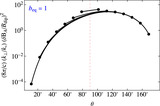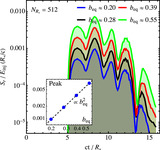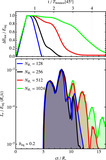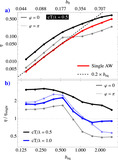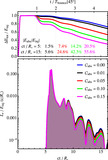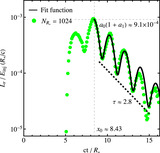Image Details
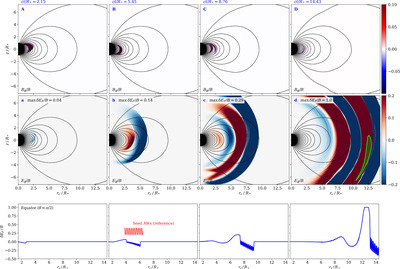
Caption: Figure 2.
Injection and mode conversion of an Alfvén wave envelope with b eq = 0.55, cT/λ = 8.0, and λ = R */4, located at θ s = 45° with width Δθ = 5°, simulated with ﹩{N}_{r}({N}_{{R}_{* }})\times {N}_{\theta }=19,968(512)\times 1600﹩. The horizontal axis shows the cylindrical radius ﹩{r}_{c}=r\sin \theta ﹩. The initially linear Alfvénic perturbation propagates along magnetic field lines, as visualized in the top row. Interaction with the curved magnetic field lines converts part of the Alfvén wave energy into fast magnetosonic modes propagating across field lines, see middle row. Alfvén waves are strongly sheared due to the different lengths of magnetic field lines (panel (C)) and bounce in the inner magnetosphere after reflection from the stellar surface (panels (C)/(D)). The fast wave amplitude relative to the magnetic field becomes significant as the generated pulses propagate outward (panel (d)), green contours denote E > B). We indicate the relative strength of the FMS wave amplitude in the middle panels. Bottom panels: outline of the FMS wave electric field δ E F /B = r c E ϕ /B along the equator (θ = π/2) at the time of the upper panels. We display the waveform of the seed Alfvén waves in red color, as a reference (not true to scale). We provide an animated version of the top panels of this figure in the article. It is also available on YouTube. The animation shows the evolution of the magnetic fields (left animation panel) and electric fields (right animation panel) during times ct/R * = 0 to 15.75; the real-time duration of the animation is 7 s.
(An animation of this figure is available in the online article.)
(An animation of this figure is available.)
The video/animation of this figure is available in the online journal.
Copyright and Terms & Conditions
© 2024. The Author(s). Published by the American Astronomical Society.


